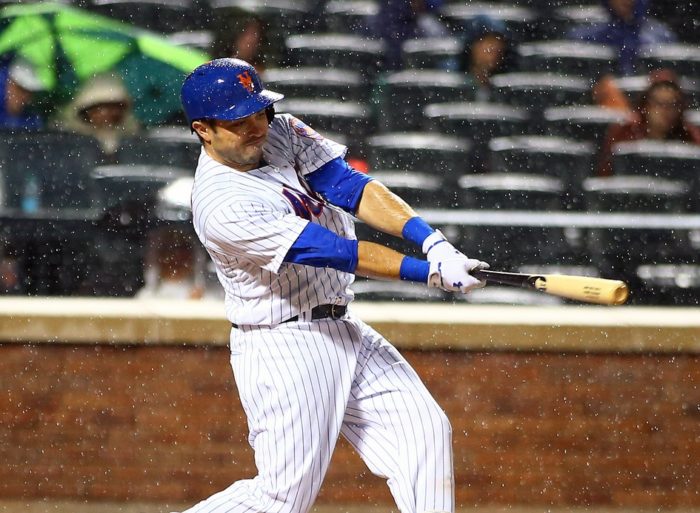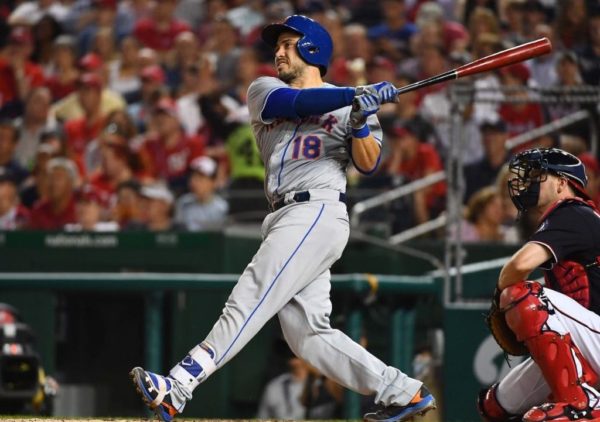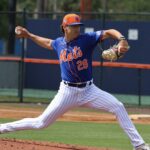
In 2018, the mere mention of the name Travis d’Arnaud is enough to bring disappointed sighs from some Mets fans. The former supplemental first-round pick (No. 37 overall in the 2007 draft), top 10 prospect (sixth at the highest), and No. 2 Eastern League prospect (behind Bryce Harper) has been riddled with bad luck and injury his entire professional career.
The common thought is that he can’t stay healthy and is injury-prone. It is a reasonable conclusion to come to, considering that d’Arnaud has faced some sort of injury in all five years that he’s spent in the Mets organization.
Even before joining the Mets organization, while in the Phillies farm system, d’Arnaud suffered his first concussion in 2008 while trying to prevent a run at the plate. In 2010, in his first year in the Blue Jays farm system, d’Arnaud suffered a herniated disk in his back, and ultimately underwent season-ending surgery.
Early 2011 saw his second career concussion off of the backswing of another player, while playing with the Blue Jays Double-A affiliate, the New Hampshire Fisher Cats. Later in the year, playing for the U.S.A. in the 39th Baseball World Cup in Panama, d’Arnaud tore ligaments in his thumb, an injury that happened during the offseason, and which he recovered from before spring training. Similarly, d’Arnaud’s 2012 season came to an end in July when he suffered a partial tear of the PCL in his left knee trying to break up a double play.
His time in the Mets organization has been similarly unkind.
Starting his tenure with the Mets in 2013, after just 12 games with Triple-A Las Vegas, d’Arnaud fractured his foot off of a foul ball while behind the plate on April 17. The injury kept him out of the lineup until July 24 and limited him to just 32 games in the minors (including his rehab assignment) and 31 games in the majors. Of course, that injury preceded a very disappointing showing for d’Arnaud in the Majors after his callup on Aug. 17, where he hit just .202/.286/.263.
The 2014 season was not much kinder to d’Arnaud. He suffered the third concussion of his career off of the backswing of Alfonso Soriano on May 13 in a game against the Yankees. He was sidelined for two weeks until May 30 against the Phillies.
He would struggle upon return, going 3-for-26 before being demoted to Triple-A. D’Arnaud’s bat would strike fire in Triple-A, where he hit .436/.475/.909 with six home runs and eight doubles in just 15 games. That earned his call back up to the major leagues lineup on June 26, and from then until the end of the season, he hit .272/.319/.486, with a .350 wOBA, and a 128 wRC+.
Nonetheless, it only picked up his season total to .242/.302/.416 with a .313 wOBA and a 102 wRC+. Slightly above average, but not up to the expectations held to him. d’Arnaud missed the last five games of 2014 with a chipped bone in his throwing elbow.
Suddenly, it all appeared to be in the cards for d’Arnaud in 2015. He got off to hot start over the team’s first 11 games. Hitting .317/.356/.537 in that time, on April 19 against the Miami Marlins, d’Arnaud was struck in the hand by a 92 mph fastball from now-teammate A.J. Ramos.
He returned on June 10 and had an .846 OPS over his next eight games, then, as luck would have it, he hyperextended his elbow from a collision play up the third base line with A.J. Pierzynski. He was on the disabled list for 32 games before returning to the lineup on July 31. His final run of the year saw 191 plate appearances in which he hit .256/.340/.464 for the remainder of the regular season, and .182/.193/.557 over three series in the post-season. His best series being the NLCS versus the Cubs, in which he hit two home runs and had a .979 OPS.
Finally, it seemed that d’Arnaud had finally figured it out. He had a career-high 2.3 WAR in 2015, despite only playing in 67 games. He even threw out 33 percent of base stealers, greater than the 28 percent league average. This level of production over a full season would put d’Arnaud among the elite catchers in the game.
D’Arnaud got off to a slow start to 2016 going 2-for-23 with four walks to start the year. He started catching a rhythm over his next six games, hitting .304 with a 119 wRC+, then it happened again. On April 25 during the course of a 5-3 victory over the Reds, d’Arnaud hurt his rotator cuff at some point attempting to throw out five base stealers in the early going.
He left the game later on during an at bat in the sixth inning. Most did not expect this injury to sideline d’Arnaud for very long, but after two weeks of no improvements, and a set back, he received a platelet-rich plasma injection in his shoulder.
His return could not have come at a better time. In 182 at-bats, Kevin Plawecki and Rene Rivera had hit .192, with a .571 OPS. Meanwhile, d’Arnaud cruised through both A+ and Triple-A during his rehab stint. His return did not go as planned, and was quite the ordeal. Making appearances in 62 games, and having plate appearances in 60 of those, d’Arnaud hit just .259/.311/.337 with a meager .285 wOBA and 78 wRC+. He finished the year hitting .247/.307/.443 with a .279 wOBA and 74 wRC+.

This was, very easily, the worst year of d’Arnaud’s career.
2017, a year with lofty expectations for d’Arnaud and the Mets, coming off of a World Series appearance in 2015, and an appearance in the Wild Card Game in 2016. The year started off great.
A 7-3 record to start the year for the team, and d’Arnaud was crushing with a .433 wOBA and 173 wRC+ over a .323/.417/.645 slash line. In the middle of that run, you may remember an at bat on April 12 in which d’Arnaud was hit on the wrist by a pitch by Vince Velasquez of the Phillies, and he proceeded to run away from Ray Ramirez as he tried to check up on him. He did stay in the game, barely avoiding injury.
Still, it is widely believed that d’Arnaud injured himself on April 19 (coincidentally the same day he was hurt in 2015), when he banged his wrist on the bat of Aaron Altherr trying to throw out Cesar Hernandez at second base. d’Arnaud did not finish the game, and was replaced by Rene Rivera.
As if an emergency brake were pulled, d’Arnaud’s season came to an abrupt stop. He went 2 for his next 28 at bats with just two walks from April 18 to May 2. He left that game with what was later discovered to be a bone bruise, and was put on the disabled list on May 5, after the swelling in his wrist would not go down.
Sidelined for only a couple of weeks, d’Arnaud returned to the lineup on May 24. He had a decent stretch from then until July first with a .323 wOBA and 101 wRC+. His struggles were evident in the months of July and August, wRC+ of 62 and 44 respectively.
Some time, during the second half, d’Arnaud seemed to change up his swing again. He went from what a toe-tap into a swing, to a bigger leg lift. It did show results, seeing how from Aug. 17 until the end of the season, d’Arnaud held a .375 wOBA and 135 wRC+. Notably, in the month of September, he hit .297/.343/.656 with a .408 wOBA and 157 wRC+ using his adjusted swing, and narrowly avoiding a knee injury in late September.
Despite the setbacks, d’Arnaud finished the season with career-highs in Games played (112), home runs (16), and RBI (57), but his final slash line was still just .244/.293/.443 and just 0.8 WAR. He also allowed the second least amount of passed balls (two) for any every day starter at catcher (min. 600 innings). Buster Posey allowed the least (one).

But what can we come to expect from d’Arnaud in 2018? Is there any room for optimism? I’d say so.
Even with the less than impressive year, d’Arnaud did have a .250 BABIP. There should definitely be at least a bit of correction there. He also held the smallest soft contact rate of his career at a low 15.4 percent, and hit the ball to all fields hitting 36.3 percent of balls to center, and 28.4 percent to the opposite field.
He also lowered his strikeout percentage to 15.7 percent, though he held his lowest walk rate of his career at just 6.1 percent. These numbers tell us that d’Arnaud is not just making contact, but making hard contact, and often.
One cannot predict whether a player will be healthy all year, but observing the kind of injuries d’Arnaud has faced over the last number of years, it would be easily distinguishable that he does not seem to have recurring injuries. d’Arnaud happens to have many freak injuries, and one would have to believe that he is the unluckiest man alive for this to continue.
As for his performance, granted that he stay on the field, 2018 could be similar to his 2015 season. Again, it is unreasonable to expect him to continue to fall victim to so much bad luck.
2018 can be the year that Travis d’Arnaud helps push the Mets forward in a playoff hunt.















